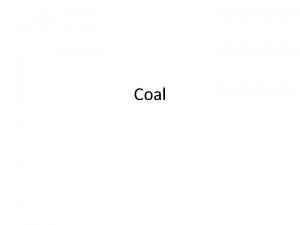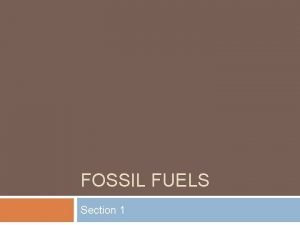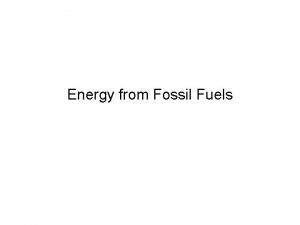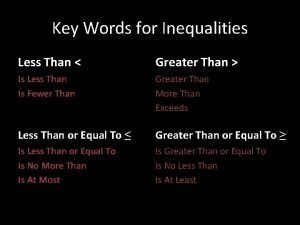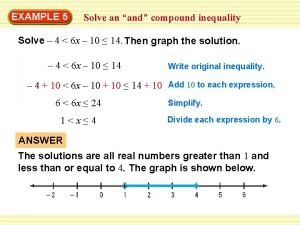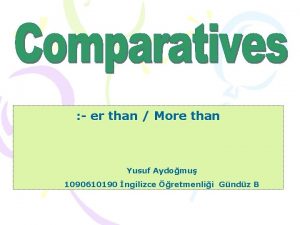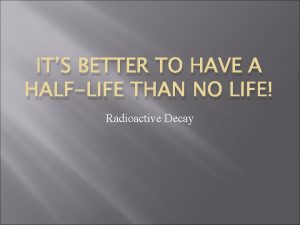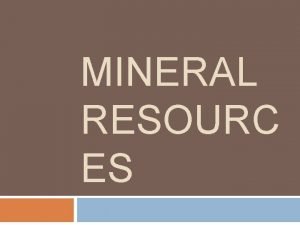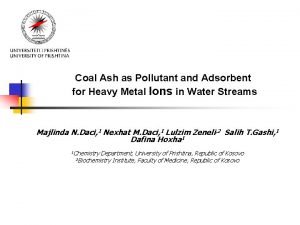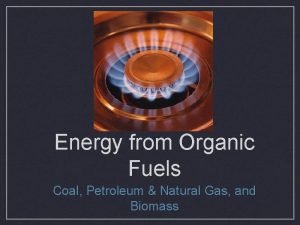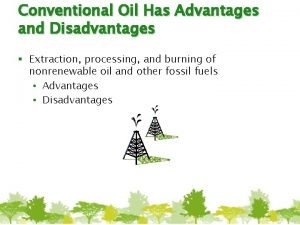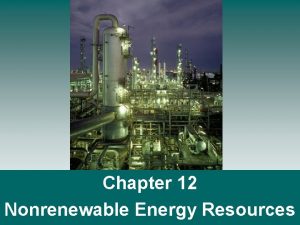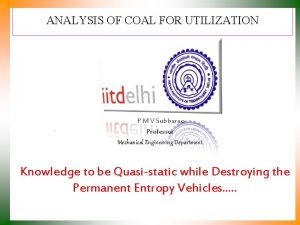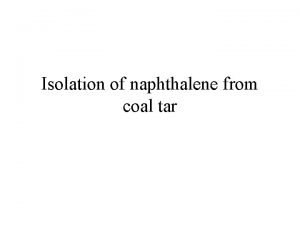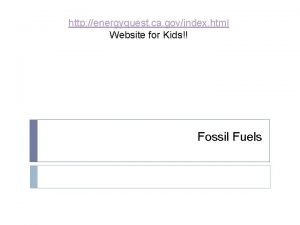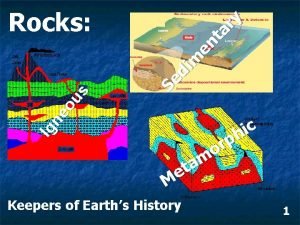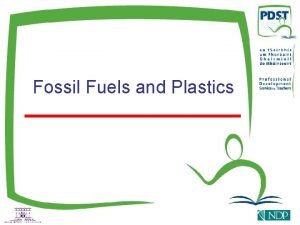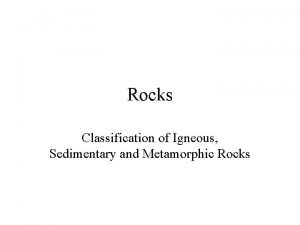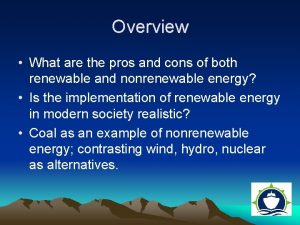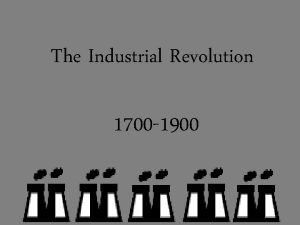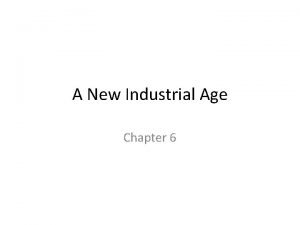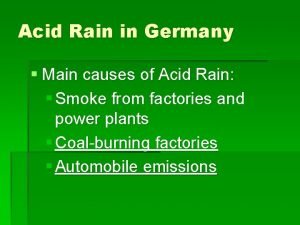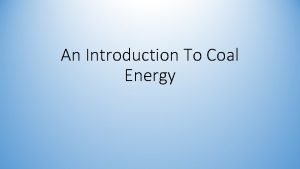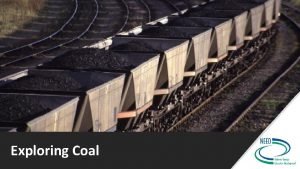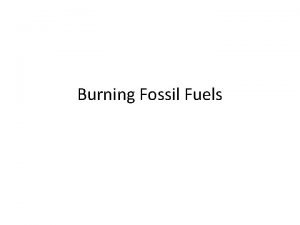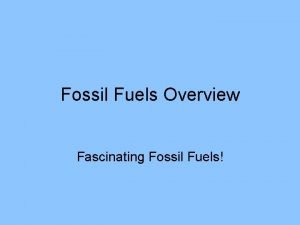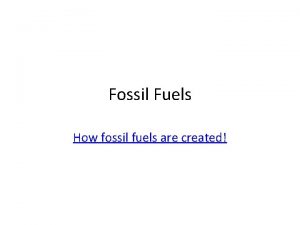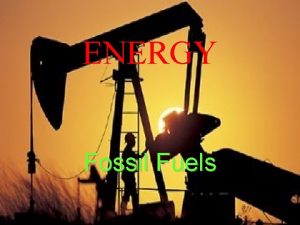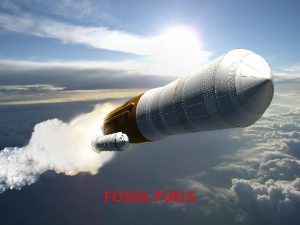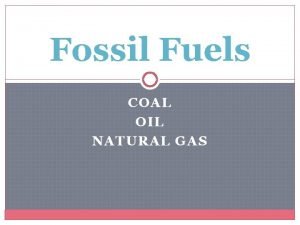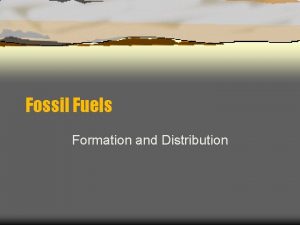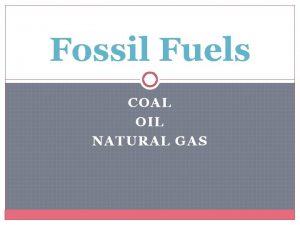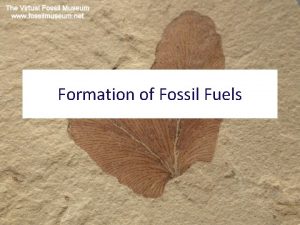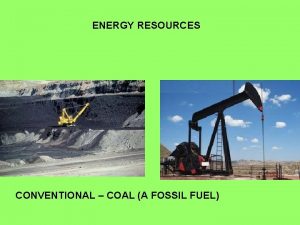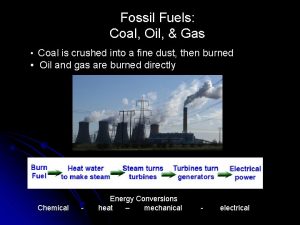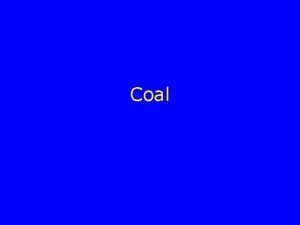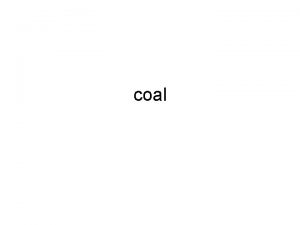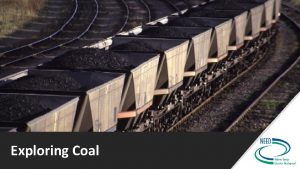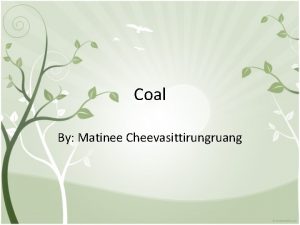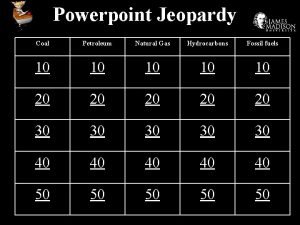Petroleum is cleaner than coal Petroleum A fossil









































- Slides: 41

Petroleum is cleaner than coal • Petroleum A fossil fuel that occurs in underground deposits, composed of a liquid mixture of hydrocarbons, water, and sulfur. • Crude oil Liquid petroleum removed from the ground. • • consists of hydrocarbons, small amounts of sulfur(S), oxygen(O), nitrogen(N), matthunt (MH) oil and natural gas often found together

Petroleum accumulation underground. Petroleum migrates to the highest point in a formation of porous rock and accumulates there. Such accumulations of petroleum can be removed by drilling a well.

Other recovery methods ● Secondary oil recovery: injecting water to force remaining oil to surface ● Enhanced or Tertiary oil recovery: uses steam or CO 2 gas to force heavy oils upward

Refining Crude Oil uses fractional distillation (different components boiled off and then condensed/ captured at different temperatures) Petroleum derivatives include: asphalt, grease, wax, naphtha, diesel oil, heating oil, aviation fuel, gasoline, etc.

Where are world oil supplies? ● most widely used E. source in developed countries, 2 nd most widely in developing countries ● OPEC- Organization of Petroleum Exporting Countries (11 countries) holds 67% of reserves: Saudi Arabia ~26%, Iraq ~10% ● other countries like Russia, Mexico, U. S. (Alaska, Gulf of Mexico) have large oil reserves but current research shows they will not expand ● U. S. imports ~57% (as of 2008) of its oil, by 2010 could be ~6570%, mainly from Canada, Mexico, Saudi Arabia, and Venezuela

OPEC

How long will supplies last? ● Current projections are that global oil supplies will last ~ 44 years ● undiscovered reserves might exist and extend time of depletion ● as of 2008, U. S. consumed approx. 1/4 of worldwide supply ● U. S. annual consumption: ~23 barrels per capita ● industrialization of China and India has incr. rate of use


Advantages of Petroleum • Convenient to transport and use • Relatively energy-dense • Cleaner-burning than coal • Oil is used in many other applications

Disadvantages of Petroleum • Releases carbon dioxide into atmosphere • Possibility of leaks when extracted and transported • Runoff enters marine waterways • Releases sulfur, mercury, lead, and arsenic into the atmosphere when burned

Disadvantages of Petroleum Arctic National Wildlife Refuge (ANWR): • Debates continue over the trade-off between extracting oil domestically and the consequences for habitat and species living near oil wells or pipelines. • Proponents of exploration suggest that ANWR might yield 25 million gallons to 378 billion gallons of oil and substantial quantities of natural gas.

Natural Gas is the Cleanest of the Fossil Fuels • Natural gas exists as a component of petroleum in the ground as well as in gaseous deposits separate from petroleum. • Natural gas contains 80 to 95 percent methane and 5 to 20 percent ethane, propane, and butane. • The two largest uses of natural gas in the United States are electricity generation and industrial processes. • Natural gas is also used to manufacture nitrogen fertilizers and in residences for heating homes and cooking.

Fracking is a form of gas and oil well drilling Drill 7, 500 feet down Forcing water, sand, and chemicals into shale – (a form of sedimentary rock) Release oil and gas


Pros and cons of fracking Pro’s ● Creates jobs nationally ● Less CO 2 emissions than using coal or oil ● Tax revenue ● Lease income from Public Lands use ● Energy independence from foreign oil , create trade surplus from export of liquid natural gas (LNG) ● Geopolitical implications Con’s ● Water and air contamination ● Harmful to humans, livestock, and crops ● Excessive water usage ● Seismic activity ● Costs for regulation, inspection, litigation, cleanup ● Cumulative effects of fracking is still unknown ● Generally unregulated ● Still produces CO 2 at significant levels ● NOT A RENEWABLE ENERGY SOURCE

Advantages of Natural Gas • Contains fewer impurities, emits almost no sulfur dioxide or particulates • Emits only 60 percent as much carbon dioxide as coal

Disadvantages of Natural Gas • Methane that escapes into the atmosphere is a potent greenhouse gas • Exploration for natural gas can contaminate groundwater

Oil sands and liquefied coal are also fossil fuels • Oil sands Slow-flowing, viscous deposits of bitumen mixed with sand, water, and clay. • Bitumen A degraded petroleum that forms when petroleum migrates to the surface of Earth and is modified by bacteria. High sulfur content • CTL (coal to liquid) The process of converting solid coal into liquid fuel.

Fossil fuels are a finite resource • Energy intensity The energy use per unit of gross domestic product. • Our energy use per capita has been dropping, but with rising population numbers, total energy use continues to rise.

Energy Intensity U. S. energy use per capita and energy intensity. Our energy use per capita was level and has been dropping in recent years. Our energy intensity, or energy use per dollar of GDP, has been decreasing steadily since 1980. However, because of the increasing U. S. population, total energy use of the nation has been roughly constant between 2000 and 2012.

The Hubbert Curve In 1969, M. King Hubbert, a geophysicist and oil company employee, published a graph showing a bell-shaped curve representing oil use. Projecting both when world oil production will reach a maximum and when the oil will finally be depleted. Question now is have we reached the peak?

The Hubbert Curve A generalized version of the Hubbert curve. Whether an upper estimate or a lower estimate of total petroleum reserves is used, the date by which petroleum reserves will be depleted does not change substantially.

The Future of Fossil Use • If current global use continues without significant additional discovery, we may run out of conventional oil in less than 50 years. • Coal supplies will last for at least 200 years, and probably much longer. • New technology and concern about the release of greenhouse gases is encouraging people to explore alternative energy sources.

Nuclear Energy Resources After this portion of the lecture, you should be able to • describe how nuclear energy is used to generate electricity. • discuss the advantages and disadvantages of using nuclear fuels to generate electricity.

Nuclear reactors use fission to generate electricity • Electricity generation from nuclear fuel uses uranium-235 as a fuel source. • Fission A nuclear reaction in which a neutron strikes a relatively large atomic nucleus, which then splits into two or more parts, releasing additional neutrons and energy in the form of heat. • A nuclear power plant uses heat from nuclear fission to boil water. This water produces the steam to turn the turbine, which turns a generator.


Nuclear Fission Nuclear fission. Energy is released when a neutron strikes a large atomic nucleus, which then splits into two or more parts.

Nuclear reactors use fission to generate electricity • Moderator is needed to slow down the fission reaction. Usually this is water. • Fuel rod A cylindrical tube that encloses nuclear fuel within a nuclear reactor. • Control rod A cylindrical device inserted between the fuel rods in a nuclear reactor to absorb excess neutrons and slow or stop the fission reaction.

Ore ● Depending on the ore, it may take up to 900 kg (2, 000 pounds) of uranium ore to produce 3 kg (6. 6 pounds) of nuclear fuel. ● Miners remove large amounts of the host rock, extract and concentrate the uranium, and leave the remaining material in slag piles ● Australia, the western United States, and parts of Canada have large commercial uranium mining operations for nuclear fuel. ● Nuclear power plants rely on 235 U as their fuel. However, most uranium ores contain as much as 99 percent 238 U, another isotope of uranium that occurs with 235 U but does not fission as easily. Therefore, when uranium ore is mined, it must be chemically enriched—a process to increase its concentration—in 235 U to be useful as a fuel.

Nuclear energy has advantages and disadvantages Advantages: • No air pollution • Reduces need to import oil Disadvantages: • Possibility of accidents • Difficult to dispose of waste • Concern about nuclear material being misused

By the 1980 s, it had become prohibitively expensive—both monetarily and politically—to attempt the construction of new nuclear power plants. Two major issues of environmental concern remain, however: the possibility of accidents and the disposal of radioactive waste. Long after nuclear fuel can produce enough heat to be useful in a power plant, it continues to emit radioactivity.

At present, nuclear power plants are required to store spent fuel rods at the plant itself. Initially, all fuel rods were stored in pools of water at least 6 m (20 feet) deep. The water acts as a shield from radiation emitted by the rods. Currently, more than 100 sites around the country are storing spent fuel rods. However, some facilities have run out of pool storage space and are now storing them in lead-lined dry containers on land Cannot be incinerated, safely destroyed using chemicals, shot into space, dumped on the ocean floor, or buried in an ocean trench because all of these options involve the potential for large amounts of radioactivity to enter the oceans or atmosphere.

Yucca Mountain In 1978, the U. S. Department of Energy began examining a site at Yucca Mountain, Nevada, 145 km (90 miles) northwest of Las Vegas for radioactive waste disposal. Some argue that the use of a fuel that consistently generates large quantities of highlevel radioactive waste is not a sustainable practice.


Radioactive waste • Radioactive waste Nuclear fuel that can no longer produce enough heat to be useful in a power plant but continues to emit radioactivity. • Becquerel (Bq) Unit that measures the rate at which a sample of radioactive material decays; 1 Bq = decay of 1 atom or nucleus per second. • Curie A unit of measure for radiation; 1 curie = 37 billion decays per second.

Radioactive Waste • High-level radioactive waste comes from used in fuel rods. • Low-level radioactive waste is found on the protective clothing, tools, rags, and other items used in routine plant maintenance. • Uranium mine tailings are the residue left after uranium ore is mined and enriched. • In each case, disposal must be handled with great care.

Fusion Power • Nuclear fusion A reaction when lighter nuclei are forced together to produce heavier nuclei. • Nuclear fusion powers the Sun and other stars. • Fusion is a promising, unlimited source of energy in the future, but so far scientists have had difficulty containing the heat that is produced.

Nuclear Accidents Fukushima, Japan, March 2011 Earthquake cut off external power to the reactors. Tsunami disabled backup diesel generators, crippling the reactor cooling systems. Overheating fuel led to hydrogen explosions that severely damaged three of the reactor buildings. Fuel melted, and radiation releases from the damaged reactors contaminated a wide area and forced the evacuation of nearly half a million residents.

Chernobyl, Ukraine (former Soviet Union), April 26, 1986 Unit 4 shut down for routine maintenance. Tested to see ability to provide sufficient electrical power to operate the reactor core cooling system and emergency equipment during a power outage. Workers’ negligence diverged from safety procedures. A sudden power surge resulted in explosions and nearly complete destruction of the reactor. Massive amounts of radiation escaped and spread across the western Soviet Union and Europe. Approximately 220, 000 people had to be relocated from their homes.

Three Mile Island Middletown, Pennsylvania, USA, March 1978 Failures in the non-nuclear secondary system, Human-operated relief valve in the primary system stuck open, allowed large amounts of nuclear reactor coolant to escape. Failure to correctly identify the problem compounded it. Human error, operator shut-down cooling system

Idaho Falls, Idaho, USA, January 3, 1961 Workers were reattaching control rods they had disconnected to enable test equipment to be inserted in the reactor core. They lifted the central control rod 20 inches, instead of the four inches that was required. Human Error Caused the reactor to go critical and its power to surge 6, 000 times higher than its normal level in less than a second. In the process, all of the water and some of the fuel was released from the reactor vessel. All three workers on duty received lethal doses of radiation, in addition to trauma from the explosion.
 What the most abundant fossil fuel
What the most abundant fossil fuel Coal is a solid fossil fuel formed from plant remains
Coal is a solid fossil fuel formed from plant remains What are the environmental impacts of fossil fuels
What are the environmental impacts of fossil fuels Numberblocks greater than less than
Numberblocks greater than less than Inequalities key words
Inequalities key words Greater than less than examples
Greater than less than examples Generous kelimesinin comparative hali
Generous kelimesinin comparative hali Odd one out fractions
Odd one out fractions 5730x5
5730x5 Percents less than 1
Percents less than 1 Your love is deeper than the ocean higher than the heavens
Your love is deeper than the ocean higher than the heavens Greater than god more evil than the devil
Greater than god more evil than the devil Fractions greater less than or equal to
Fractions greater less than or equal to Coal candy with hammer
Coal candy with hammer Coal tot
Coal tot Coal strip mining
Coal strip mining Lignite kosovo
Lignite kosovo Stages of coal formation
Stages of coal formation Which phrase best describes the focus of ecology
Which phrase best describes the focus of ecology Take the coal cleanse my lips here i am
Take the coal cleanse my lips here i am Coal formation
Coal formation Research fund for coal and steel
Research fund for coal and steel An abundance of coal an irregular coastline
An abundance of coal an irregular coastline Coal advantages
Coal advantages Alex coal pmv
Alex coal pmv Naphthalene from coal tar
Naphthalene from coal tar Where does coal come from
Where does coal come from Black as coal figurative language
Black as coal figurative language Anthracite coal foliated or nonfoliated
Anthracite coal foliated or nonfoliated Coal oil
Coal oil Metamorphic
Metamorphic As coal deposits were used up, britain turned to
As coal deposits were used up, britain turned to Children working in coal mines
Children working in coal mines Sedimentary igneous rocks
Sedimentary igneous rocks Cons of coal
Cons of coal Eli whitney cotton gin
Eli whitney cotton gin Organized coal miners their wives
Organized coal miners their wives What kind of sedimentary rock is coal
What kind of sedimentary rock is coal Coal and acid rain
Coal and acid rain What do we use coal for
What do we use coal for Summarize roosevelt's approach to environmental problems
Summarize roosevelt's approach to environmental problems Formation of coal
Formation of coal
